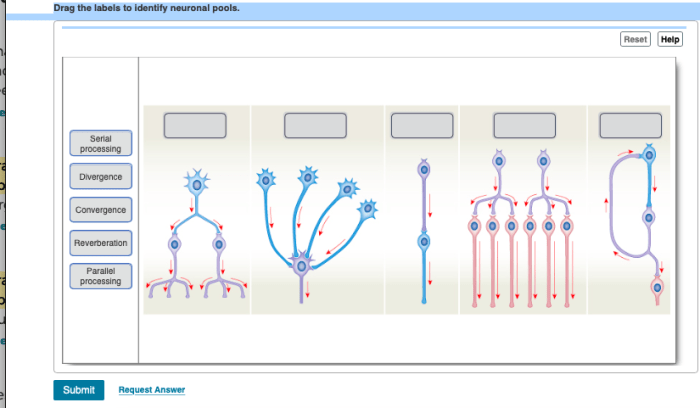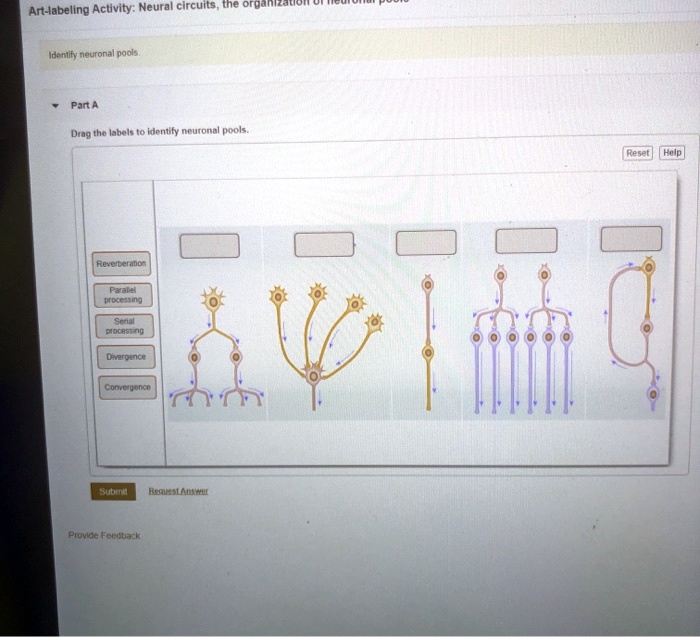Drag the labels to identify neuronal pools is a groundbreaking technique revolutionizing neuroscience research. This method empowers researchers to explore the intricacies of brain function and unravel the mysteries of neurological disorders.
By harnessing the power of visual representation and data analysis, drag and drop labeling enables scientists to identify and characterize neuronal pools, unlocking a deeper understanding of the brain’s complex circuitry.
Drag and Drop Labeling: Drag The Labels To Identify Neuronal Pools

Drag and drop labeling is a technique used in neuroscience research to identify and label neuronal pools. It involves dragging and dropping labels onto neuronal clusters in a graphical representation of neural data, such as a scatter plot or a dendrogram.
This technique allows researchers to manually assign labels to neuronal pools based on their electrophysiological properties, connectivity patterns, or other characteristics. By dragging and dropping labels, researchers can create a custom labeling scheme that reflects their understanding of the data and facilitates further analysis.
Advantages and Disadvantages, Drag the labels to identify neuronal pools
- Advantages:
- Flexibility: Allows researchers to create custom labeling schemes that are tailored to their specific research questions.
- Intuitive: The graphical interface makes it easy to visualize and interact with the data.
- Iterative: Researchers can refine their labeling scheme as they gain more insights into the data.
- Disadvantages:
- Subjectivity: The labeling process is subjective and can be influenced by the researcher’s biases.
- Time-consuming: Manual labeling can be a time-consuming process, especially for large datasets.
- Scalability: It can be challenging to scale up drag and drop labeling to very large datasets.
Neuronal Pool Identification
Neuronal pools are groups of neurons that share similar properties, such as their firing patterns, connectivity, or neurochemical profile. They are thought to be the fundamental units of brain function, and their identification is crucial for understanding how the brain processes information.
Various methods are used to identify neuronal pools, including:
- Electrophysiological recordings: Measuring the electrical activity of neurons to identify neurons with similar firing patterns.
- Calcium imaging: Visualizing the calcium levels in neurons to identify neurons that are active together.
- Patch-clamp recordings: Recording the electrical currents of individual neurons to identify neurons with similar ion channel properties.
Drag and drop labeling can assist in neuronal pool identification by providing a visual representation of the data and allowing researchers to manually group neurons based on their characteristics.
Data Analysis and Visualization

Once neuronal pools have been identified, various data analysis techniques can be used to interpret the results of drag and drop labeling. These techniques include:
- Statistical analysis: Using statistical tests to determine whether the differences between neuronal pools are significant.
- Clustering algorithms: Automatically grouping neurons into pools based on their similarities.
- Network analysis: Analyzing the connections between neuronal pools to understand their functional relationships.
Visualizing the data is crucial for understanding the relationships between neuronal pools. Common visualization techniques include:
- Scatter plots: Plotting the properties of neurons on a scatter plot to identify clusters of similar neurons.
- Dendrograms: Creating a tree-like diagram that shows the hierarchical relationships between neuronal pools.
- Network graphs: Visualizing the connections between neuronal pools as a graph.
Applications and Impact

Drag and drop labeling has a wide range of applications in neuroscience, including:
- Brain mapping:Identifying and mapping neuronal pools in different brain regions.
- Circuit analysis:Understanding the functional relationships between neuronal pools.
- Disease research:Investigating how neuronal pool dysfunction contributes to neurological disorders.
This technique has significantly impacted our understanding of brain function and disorders. It has led to the discovery of new neuronal pool types, the identification of circuits involved in specific behaviors, and the development of new therapeutic strategies for neurological diseases.
Future directions and advancements in this area of research include:
- Automated labeling:Developing algorithms that can automatically identify and label neuronal pools.
- Large-scale analysis:Applying drag and drop labeling to large-scale datasets to identify neuronal pools in complex brain networks.
- Integration with other techniques:Combining drag and drop labeling with other techniques, such as optogenetics and chemogenetics, to manipulate and study neuronal pools.
Expert Answers
What is the concept behind drag and drop labeling?
Drag and drop labeling is a technique that allows researchers to identify neuronal pools by assigning labels to individual neurons based on their electrophysiological properties.
How does drag and drop labeling assist in identifying neuronal pools?
By dragging and dropping labels onto neurons with similar properties, researchers can group them into distinct neuronal pools, revealing the functional organization of the brain.
What are the advantages of using drag and drop labeling?
Drag and drop labeling offers advantages such as ease of use, visual representation, and the ability to incorporate multiple parameters for neuron classification.